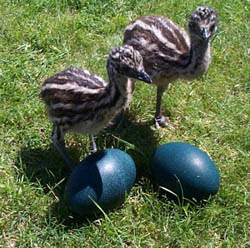Emu Farming Catches Haryana’s Fancy
Posted by Unknown in Emu and Ostrich, India on Sunday, 27 January 2013
It's
not just Ullawas village, close to Gurgaon's corporate hub, which is
attracting attention because emu is reared here. The trend of emu
farming has caught up across Haryana in recent years.
About
100 farms of this bird of Australian origin have already come up in
various parts of the state with about eight such farms in Hisar
district. A government spokesperson said that more people are taking up
this business since emu rearing is largely risk-free.
The
giant birds cannot fly and have the strength to survive in zero degree
celsius as well as 52 degrees celsius. With a high degree of resistance,
they remain free from all kinds of diseases and have a lifespan of
30-40 years. A senior official said that these birds eat leaves,
vegetables, fruits, insects and grains and drink eight to ten litres of
water daily, which is amply available in the state. One emu needs 6-8
feet space to live in. He added that one needs to invest about Rs 24.78
lakh to purchase 50 pairs of these birds and construct a shed and make
arrangements for water.
"Rearing
of emu is going to be the first choice for farmers and a major source
of employment and additional income. We expect more people to take up
this business," said the official. Emu rearing was first started in
Australia and it being high-yielding and zero-risk farming, it was
adopted as a profession in America, European countries, China, Japan,
Malaysia, Korea and in India it was adopted in AP and Maharashtra in
1996. Thereafter the farmers of Tamil Nadu, Goa, Orissa and MP started
their farming and now it has become a good option for Haryana farmers.
Officials
said that every limb of emu is useful. Its egg, feather, mutton, empty
shell of egg, nails, oil and skin all are useful. One Emu sheds 400-600
grams of feathers in a year which is used to make caps, costumes and
brushes for cleaning computers and cars. One emu egg weighs 500-700
grams and it can fetch Rs 1,000 to Rs 1,200 in the market. Emu starts
laying egg in the age of two or two and a half years and continue to lay
up to 30 years. In first year it lays up to 100 eggs, second year 200
eggs and in third year it lays up to 300 or more eggs. "So, there is
long-term benefit for farmers. With a huge quantity of foodgrain
available in rural Haryana, we expect the farming will be much more,"
said an official.
Times of India
This entry was posted on Sunday, 27 January 2013 at 10:34 and is filed under Emu and Ostrich, India. You can follow any responses to this entry through the RSS 2.0. You can leave a response.
- No comments yet.






